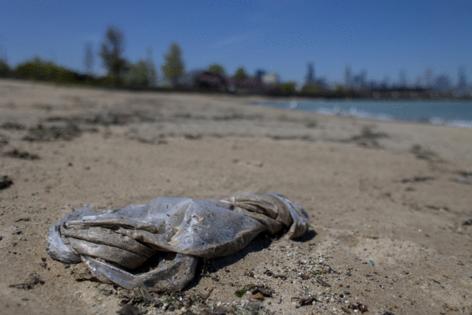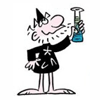86% of Great Lakes litter is plastic, a 20-year study shows. And the plastic is 'just getting smaller and smaller.'
Published in News & Features
CHICAGO — Heads down and attentively scanning the ground, a small group of schoolchildren walked through an expanse of grass dotted with yellow dandelions and toward the concrete steps leading to Lake Michigan.
Andrew Scarpelli, a biologist, ambassador for the Alliance for the Great Lakes and guide for this cleanup effort, asked the children if they had a favorite animal that lived around the lake.
“Cardinals!” “Seagulls!” “Woodpeckers!” “Owls!” the kids yelled out.
“We’re doing this for them,” Scarpelli said.
Using data from more than 14,000 beach cleanups over 20 years, a new report from the nonprofit Alliance for the Great Lakes found that 86% of litter entering the Great Lakes in a given year is either partially or fully composed of plastic. Previous estimates and computer simulations indicated that 22 million pounds of plastic debris entered the lakes annually, at that time making up 80% of shoreline litter.
Large plastic products left behind on beaches, including single-use bags, straws, wrappers, takeout containers and utensils, eventually break down into smaller plastic particles. The tiniest of these — less than 5 millimeters long or the size of a pencil eraser — are known as microplastics and have been found in drinking water and human blood, organs and breast milk.
“There’s that tangible thing with the story of the sea turtle and the straw,” said Krystyna Meyer, coordinator of conservation action at the Shedd Aquarium, referring to a 2015 viral video of a straw being removed from a turtle’s nose. “But it’s the stuff that we don’t see that’s actually causing much bigger issues.”
For decades, plastic pollution of different shapes and sizes has been steadily flowing into the world’s largest freshwater system, which provides drinking water for more than 30 million people. It threatens the health of humans and wildlife, and the well-being of the region’s aquatic habitats and green spaces.
For volunteers and researchers, quantifying this pollution is the first step toward pressuring politicians and industry players to enact changes at the source.
“Plastic is not disappearing — it’s just getting smaller and smaller,” said Olivia Reda, author of the report and volunteer engagement manager at the alliance. “I think finding these pieces of tiny trash is definitely sort of eye-opening to folks, to start thinking about the smaller things. … What happens when you can’t even see them anymore?”
...continued
©2024 Chicago Tribune. Visit chicagotribune.com. Distributed by Tribune Content Agency, LLC.







Comments